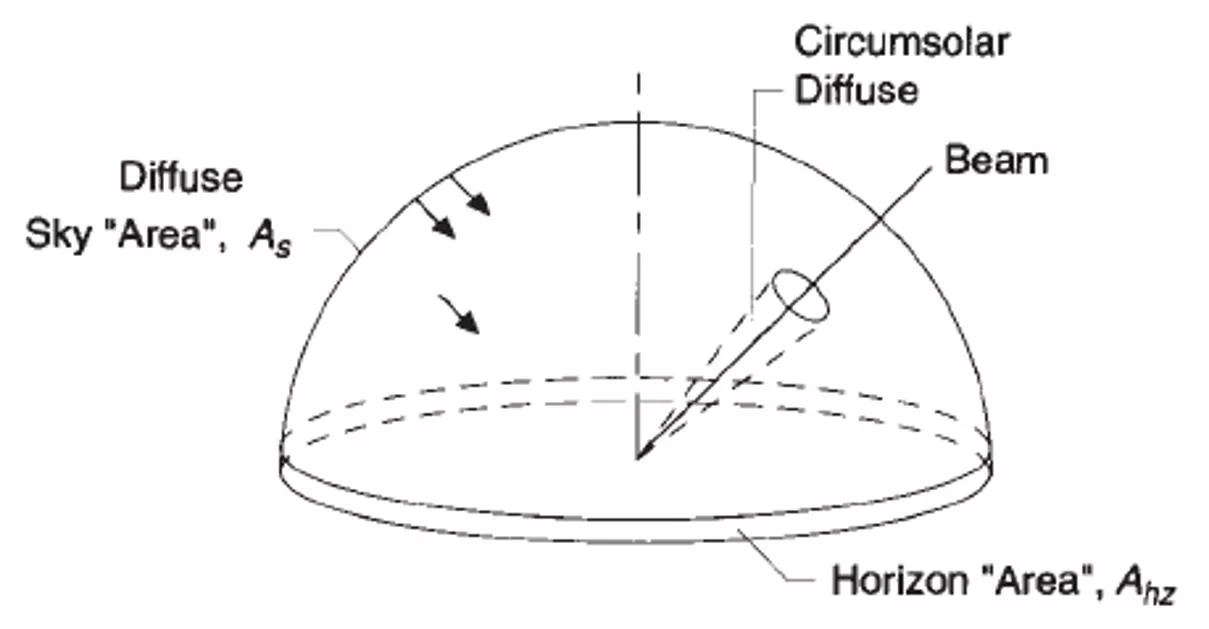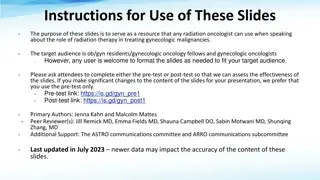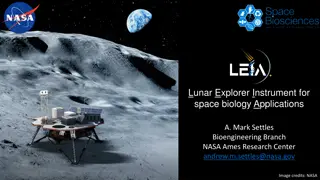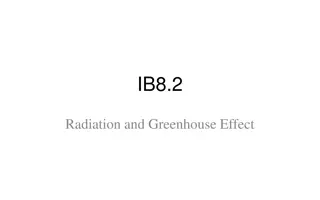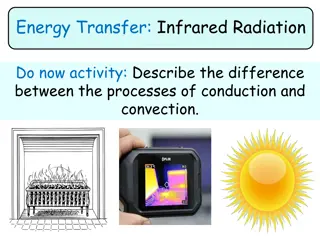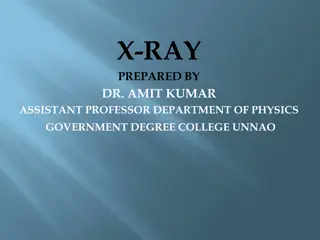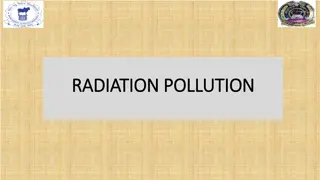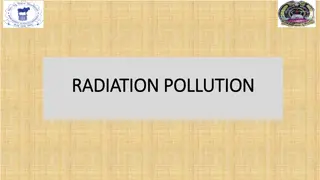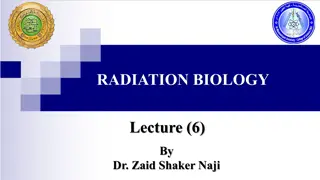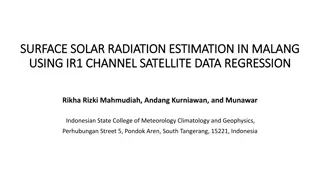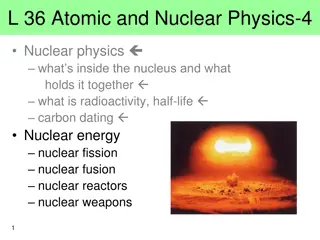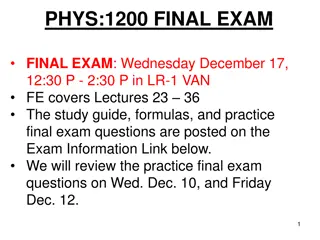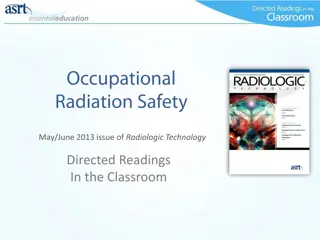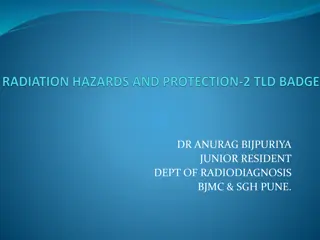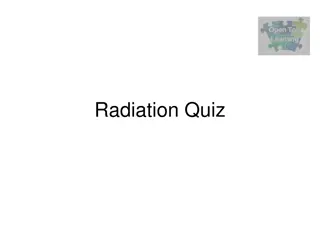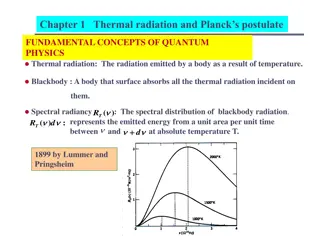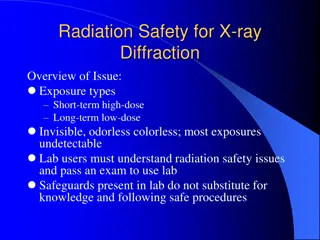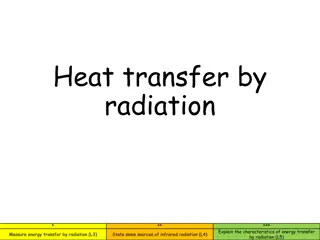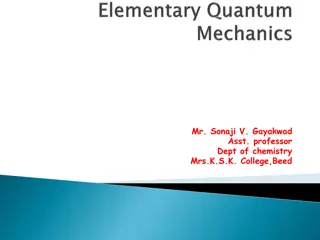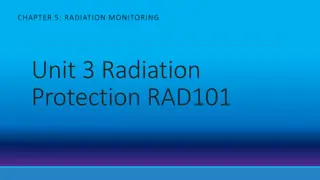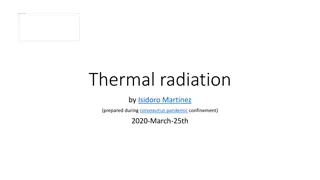Calculation of Radiation on Sloped Surfaces
The general problem of calculating radiation on tilted surfaces when only the total radiation on a horizontal surface is known involves determining the direction from which the beam and diffuse components reach the surface. Diffuse radiation models consist of three parts: isotropic, circumsolar, and horizon brightening. Various sky models treat these parts differently, leading to different methods for calculating incident radiation on sloped surfaces based on theoretical or empirical parameters. Multiple models of varying complexity have been developed for this purpose, with preferred methods based on assumptions about the directional distribution of diffuse radiation.
Download Presentation

Please find below an Image/Link to download the presentation.
The content on the website is provided AS IS for your information and personal use only. It may not be sold, licensed, or shared on other websites without obtaining consent from the author.If you encounter any issues during the download, it is possible that the publisher has removed the file from their server.
You are allowed to download the files provided on this website for personal or commercial use, subject to the condition that they are used lawfully. All files are the property of their respective owners.
The content on the website is provided AS IS for your information and personal use only. It may not be sold, licensed, or shared on other websites without obtaining consent from the author.
E N D
Presentation Transcript
2.14 RADIATION ON SLOPED SURFACES We turn next to the general problem of calculation of radiation on tilted surfaces when only the total radiation on a horizontal surface is known. For this we need the directions from which the beam and diffuse components reach the surface in question. Section 1.8 dealt with the geometric problem of the direction of beam radiation. The direction from which diffuse radiation is received, that is, its distribution over the sky dome, is a function of conditions of cloudiness and atmospheric clarity, which are highly variable
Research data suggest a diffuse radiation model as being composed of three parts. The first is an isotropic part, received uniformly from the entire sky dome. The second is circumsolar diffuse, resulting from forward scattering of solar radiation and concentrated in the part of the sky around the sun. The third, referred to as horizon brightening, is concentrated near the horizon and is most pronounced in clear skies. Figure 2.14.2 shows schematically these three parts of the diffuse radiation. Many sky models have been devised. The differences among them are in the way they treat the three parts of the diffuse radiation.
The incident solar radiation is the sum of a set of radiation streams including beam radiation, the three components of diffuse radiation from the sky, and radiation reflected from the various surfaces seen by the tilted surface. The total incident radiation on this surface can be written as where the subscripts iso, cs, hz, and refl refer to the isotropic, circumsolar, horizon, and reflected radiation streams Equation 2.14.1 can be rewritten in a useful form in terms of parameters that can be determined either theoretically or empirically This equation, with variations, is the basis for methods of calculating IT that are presented in the following sections.
Many models have been developed, of varying complexity, as the basis for calculating IT . The differences are largely in the way that the diffuse terms are treated. The simplest model is based on the assumptions that the beam radiation predominates and that the diffuse (and ground-reflected radiation) is effectively concentrated in the area of the sun. Then all radiation is treated as beam. This leads to substantial overestimation of IT , and the procedure is not recommended. Preferred methods are given in the following sections and are based on various assumptions about the directional distribution of the diffuse radiation incident on the tilted surface.
2.15 RADIATION ON SLOPED SURFACES: ISOTROPIC SKY It can be assumed [as suggested by Hottel and Woertz (1942)] that the combination of diffuse and ground-reflected radiation is isotropic. With this assumption, the sum of the diffuse from the sky and the ground- reflected radiation on the tilted surface is the same regardless of orientation, and the total radiation on the tilted surface is the sum of the beam contribution calculated as IbRb and the diffuse on a horizontal surface, Id . This represents an improvement over the assumption that all radiation can be treated as beam, but better methods are available.
The isotropic diffuse model, derived by Liu and Jordan An improvement on Hottel and Woertz model, is the isotropic diffuse model, derived by Liu and Jordan (1963). The radiation on the tilted surface was considered to include three components: beam, isotropic diffuse, and solar radiation diffusely reflected from the ground. The third and fourth terms in Equation 2.14.3 are taken as zero as all diffuse radiation is assumed to be isotropic. Thus Equation 2.14.3 is modified to give the total solar radiation on the tilted surface for an hour as the sum of three terms:
2.16 RADIATION ON SLOPED SURFACES: ANISOTROPIC SKY The isotropic diffuse model is easy to understand, is conservative (i.e., it tends to underestimate IT ), and makes calculation of radiation on tilted surfaces easy However, improved models have been developed which take into account the circumsolar diffuse and/or horizon- brightening components. Hay and Davies (1980) estimate the fraction of the diffuse that is circumsolar and consider it to be all from the same direction as the beam radiation; they do not treat horizon brightening. Reindl et al. (1990b) add a horizon brightening term to the Hay and Davies model, as proposed by Klucher (1979), giving a model to be referred to as the HDKR model. Perez et al. (1987, 1988, 1990) treat both circumsolar diffuse and horizon brightening in some detail in a series of models. Neumann et al. (2002) propose a model for circumsolar radiation that is of particular importance in predicting the performance of concentrating systems where the angular distribution of energy near the sun s disc is important.
The HDKR model Reindl et al. (1990b) add a horizon brightening term to the Hay and Davies model, as proposed by Klucher (1979), giving a model to be referred to as the HDKR model.
The question is which of these models for total radiation on the tilted surface should be used?
general rules of thumb For maximum annual energy availability, a surface slope equal to the latitude is best. For maximum summer availability, slope should be approximately 10 to 15 less than the latitude. For maximum winter energy availability, slope should be approximately 10 to 15 more than the latitude. The slopes are not critical; deviations of 15 result in reduction of the order of 5%. The best surface azimuth angles for maximum incident radiation are 0 in the northern hemisphere, that is, the surfaces should face the equator. Deviations in azimuth angles of 10 or 20 have small effect on total annual energy availability.



